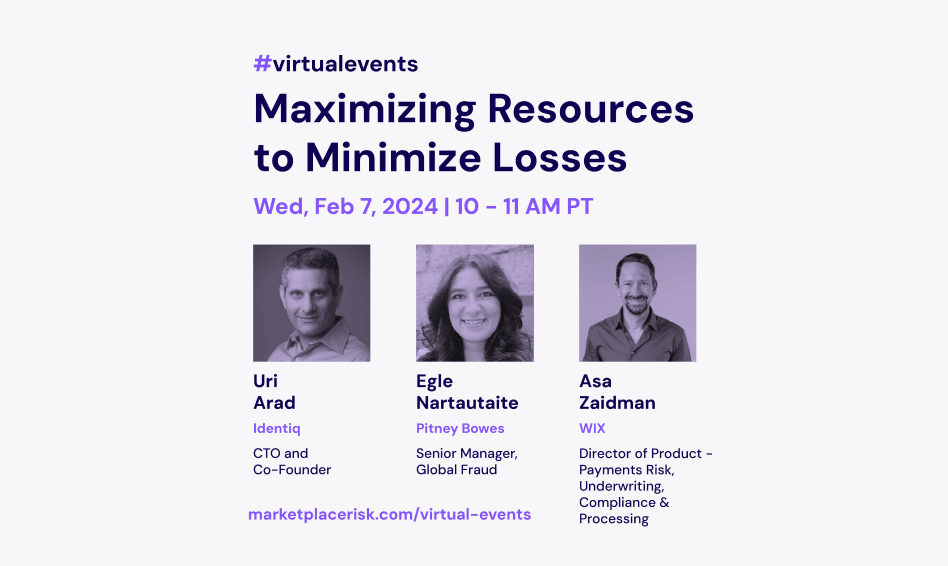Maximizing Resources to Minimize Losses
- Webinars

- Ariella Rothschild
We’re in times of economic uncertainty, and for businesses, the bottom line is more important than ever. Many fraud and risk teams are asking themselves what this means for their team. That’s why we brought together fraud leaders to discuss fraud prevention and resource optimization during the economic downturn for a lively webinar with Marketplace Risk.
Fraud leaders Egle Nartautaite, Senior Manager of Global Fraud at Pitney Bowes, and Asa Zaidman, Director of Product, Payments, Risk, Underwriting, Compliance & Processing at Wix, talked it out with Identiq CTO and co-founder Uri Arad.
Watch the recording, or read the webinar highlights below:
Fraud in 2024
During an economic downturn, there is typically an increase in fraud and tighter budgets. As a result, companies that were once eager to expand their resources may now be more cautious. Companies are, therefore, faced with the challenge of achieving more with limited resources. They’re also tasked with focusing not solely on lost revenue, but revenue generation becomes more important as well. In order for fraud and risk teams to effectively address both aspects, they need to understand the priorities of stakeholders and their risk appetite.
In the words of Nartautaite, “Fraud people want to do it all. But in the kind of times we’re facing, we can’t. So you need to understand what’s important for your organization.”
Companies will need to balance customer satisfaction and risk. Here is where data plays a vital role. It is crucial to extract as much value as possible from available data, even if it is not the most sophisticated.
Metrics for success
Each organization will have its own parameters and priorities, which will determine what metrics to focus on. High acceptance rate will be the KPI when the focus is on customer satisfaction, while low fraud rates will be the focus if minimizing losses is the priority.
At Pitney Bowes, they measure customer satisfaction by monitoring and addressing user complaints and requests. When measures are taken to improve acceptance rates, they see fewer complaints regarding declined transactions. Once they become more familiar with buyers, complaints are reduced.
For specific cases, Nartautaite’s team will promptly take action when transactions from a particular type of merchant are being declined frequently. They then can address the issue immediately and make necessary adjustments.
Shifting Focus to Gains Rather than Losses
Top priority for Nartautaite’s team is customer satisfaction, and therefore, they take more calculated risks with customers. When it comes to high-risk customers, they monitor their activity instead of declining them immediately. Only once fraud surpasses their established risk thresholds is action taken.
Nartautaite explains that this approach is due to advancements in technology that make indicators of high risk not as clear as they once were. What was once considered an indicator of high risk a decade ago has become less reliable. Factors such as credit cards issued from different countries, VPN usage, or device fingerprints have become commonplace. Therefore, the simple indicators that previously indicated fraud are no longer as effective, and time must be given to evaluate transactions that initially appear high risk. At the same time, background checks should be conducted diligently, and interventions should be made to safeguard against potential risks.
Evaluating new tools
To effectively evaluate new tools, it’s key first to identify the risk areas that pose the biggest threats. Then, assess whether the existing tools are still effective or if more efficient options are available. Understand the ROI that can be expected from implementing the new tool. Remaining open to exploring multiple tools will help find the best fit. Additionally, panelists note to consider the effort required for implementation and whether the tool can be maintained in the future.
Zaidman points out that It is common for vendors to claim expertise in all areas, which of course, seems appealing. However, he stresses that it is necessary to exercise caution when a company says it can do it all. You need to ask questions and verify whether the promised capabilities can indeed be delivered as expected.
Doing More With Less
2024 will ask a lot from risk teams– revenue needs to increase while losses will be more significant. However, by understanding the priorities of stakeholders and their risk appetite, they can effectively address both revenue generation and loss prevention. Data, understanding priorities, and measuring current and potential tools play a crucial role in finding this balance. While key metrics for success will vary across organizations, prioritizing customer satisfaction and minimizing losses can guide the focus. Evaluating current and new tools should be prioritized based on the biggest threats to risk areas while understanding ROI is essential.
Looking to learn more about how you can stay ahead in 2024? Check out our 12 tips to optimize your fraud investment
Download Free eBook
Identiq Spotlight

2024 trends
Quantum threats to encryption, advanced AI attacks, supply chain security focus, decentralized identity rise, and ransomware …
May 4, 2024

Marketing and fraud collaboration
Quantum threats to encryption, advanced AI attacks, supply chain security focus, decentralized identity rise, and ransomware …
May 4, 2024

